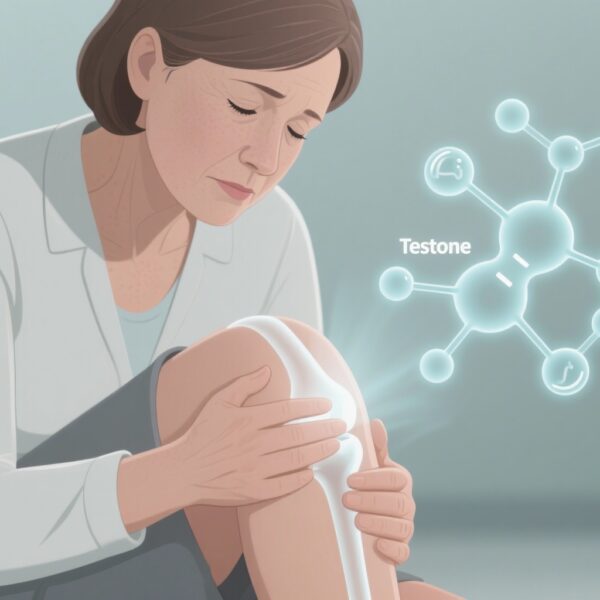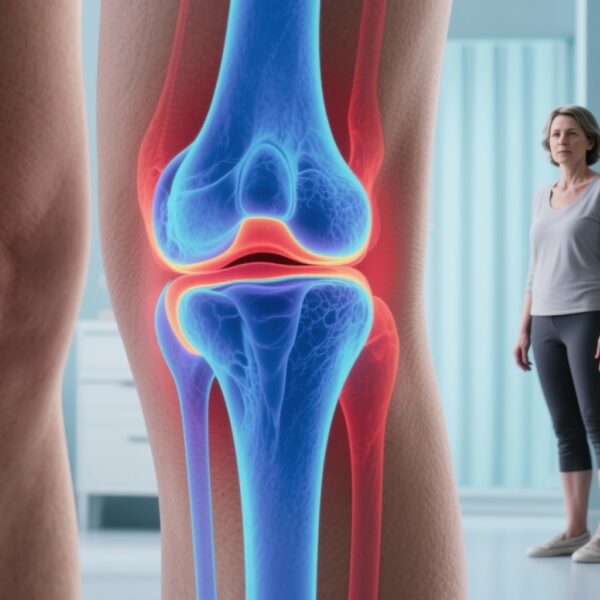Highlights
– Approximately half of known knee osteoarthritis (KOA) genome-wide significant variants colocalize with BMI loci; partitioning the KOA polygenic risk score (PRS) into BMI-associated and BMI-independent components distinguishes pathways and prediction performance.
– In a UK Biobank analysis (n=345,080 Europeans), the BMI-associated KOA-PRS showed partly BMI-mediated associations with incident KOA, whereas the BMI-independent KOA-PRS retained robust effects after BMI adjustment.
– The BMI-independent PRS was negatively associated with BMI among KOA cases and showed attenuated effect sizes in higher BMI strata, suggesting heterogeneity of genetic effects by adiposity.
Background
Knee osteoarthritis (KOA) is a leading cause of pain, disability, and healthcare utilization in older adults. Risk factors are multifactorial: age, female sex, joint injury, occupational loading, and obesity stand out. Body mass index (BMI) is both a strong modifiable risk factor and a trait with substantial heritability; genetic loci influencing BMI may therefore also contribute to KOA risk through shared or mediated pathways.
Polygenic risk scores (PRSs) aggregate small effects across many common genetic variants and are increasingly evaluated for risk stratification in common diseases. For KOA, PRSs based on genome-wide association study (GWAS) hits can improve prediction, yet interpretation and clinical use are complicated when many KOA loci are also associated with BMI. Distinguishing BMI-mediated from BMI-independent genetic effects may clarify mechanisms, avoid double-counting risk when combining PRS and measured BMI, and improve predictive accuracy and clinical decision-making.
Study design
The study by Sedaghati-Khayat et al. used 345,080 white European participants from the UK Biobank to refine a KOA-PRS and partition it according to association with BMI. The starting set comprised 146 genome-wide significant KOA variants reported by the Genetics of Osteoarthritis (GO) consortium. Using linkage disequilibrium (LD) relationships with BMI-associated variants identified by the GIANT consortium, KOA loci were classified as BMI-associated (KOA-BMI) or BMI-independent (KOA-nonBMI).
Analyses evaluated associations of each PRS with prevalent and incident KOA (with and without adjustment for BMI), associations with BMI in cases and controls, and effect modification across BMI strata. Odds ratios (OR) per standard deviation (SD) of PRS with 95% confidence intervals (CI) quantified risk; linear models assessed BMI associations.
Key findings
Of the 146 KOA-associated variants, 73 (≈50%) were classified as BMI-associated by the LD-based partitioning strategy. Main results included:
- KOA-BMI PRS and incident KOA: OR per SD 1.23 (95% CI 1.20–1.26). This association attenuated after adjusting for measured BMI to OR 1.18 (1.15–1.21), consistent with partial mediation via adiposity.
- KOA-nonBMI PRS and incident KOA: OR per SD 1.24 before BMI adjustment and 1.23 after adjustment, indicating BMI-independent genetic effects on KOA risk.
- Association with BMI in cases and controls: The KOA-nonBMI PRS exhibited a small negative association with BMI among KOA cases (β = -0.09; 95% CI -0.17 to -0.01), but no clear association in controls. This suggests that among those who develop KOA, higher non-BMI genetic risk associates with lower BMI—consistent with phenotypic heterogeneity.
- Effect modification by BMI strata: The KOA-nonBMI PRS effect on KOA risk diminished in higher BMI strata, whereas KOA-BMI PRS effects remained stable across BMI categories. This pattern suggests the non-BMI genetic contributors to KOA may be relatively more important at lower BMI, while at higher BMI the relative contribution of these loci is reduced compared with the dominant influence of adiposity-related mechanisms.
Clinical and statistical interpretation
Partitioning improved interpretability: the KOA-BMI component captures genetic risk that operates at least partly through adiposity, and its association with KOA is attenuated when accounting for measured BMI. The KOA-nonBMI component captures genetic influences that operate independently of BMI and remains robust after BMI adjustment. Clinically, this distinction matters when integrating PRS with measured BMI for risk prediction—simply adding an aggregate KOA-PRS and BMI may double-count adiposity-driven genetic effects unless partitioned.
Comparative performance and implications for prediction
Although specific measures of discrimination (e.g., AUC) and net reclassification were not detailed in the summary, the findings suggest that partitioned PRS components can provide more nuanced information: the BMI-independent PRS gives additive, BMI-agnostic risk, whereas the BMI-associated PRS partly overlaps with measured BMI and may add less incremental predictive value after BMI inclusion. In practice, a model that includes measured BMI plus the KOA-nonBMI PRS may be preferable to a model that includes an undifferentiated PRS plus BMI.
Expert commentary
Strengths of the work include the use of large, well-phenotyped UK Biobank data, leveraging established GWAS catalogs (GO and GIANT), and an explicit strategy to partition genetic risk by LD with BMI loci. The approach addresses an important and pragmatic problem for translational genetics: how to integrate PRS with clinical risk factors that themselves have shared genetic architecture.
Limitations and cautions are important to consider:
- Population ancestry: Analyses were restricted to white European participants. PRS performance and LD patterns vary by ancestry; external validation and re-derivation in diverse populations are essential before clinical implementation.
- LD-based partitioning is a pragmatic but imperfect proxy for causal mediation. Colocalization analyses and Mendelian randomization (MR) can provide stronger evidence for whether a shared locus exerts effects on KOA via BMI versus via independent pathways. Without those, residual pleiotropy or independent nearby causal variants cannot be excluded.
- Adjustment for BMI can introduce collider bias in some settings: conditioning on a downstream mediator or a variable influenced by both exposure and outcome could induce spurious associations. The pattern observed—attenuation of KOA-BMI PRS after BMI adjustment—is biologically plausible, but causal inference requires careful methods (e.g., mediation analysis with genetic instruments, multivariable MR).
- Clinical utility metrics were not fully described in the summary. Translating partitioned PRS into practice requires demonstrating improved discrimination, calibration, clinical reclassification, cost-effectiveness, and acceptability compared with standard risk models.
Biological plausibility: The coexistence of BMI-associated and BMI-independent genetic drivers is consonant with existing knowledge that KOA arises from both mechanical loading (amplified by obesity) and intrinsic joint biology (cartilage, bone, synovium, inflammatory signaling). Partitioning may therefore help map genetic signals onto these mechanistic axes and prioritize targets for functional follow-up.
Conclusion and implications for practice
Partitioning KOA genetic variants by their association with BMI clarifies genetic architecture and improves interpretability of polygenic risk. The KOA-BMI component appears partly mediated by adiposity, while the KOA-nonBMI component identifies BMI-independent genetic susceptibility. For clinical risk prediction, combining measured BMI with a BMI-independent PRS is likely to avoid redundancy and better capture non-adiposity genetic risk.
Next steps include validation in non-European ancestry cohorts, application of formal causal methods (colocalization, multivariable MR), exploration of added predictive value using discrimination and reclassification metrics, and functional studies to connect BMI-independent loci with joint-specific biology. If validated, partitioned PRSs could inform personalized prevention strategies—e.g., more aggressive weight management for individuals with high KOA-BMI genetic risk and alternative early interventions for those with high KOA-nonBMI risk.
Funding and clinicaltrials.gov
The analysis used UK Biobank resource data. The primary study citation: Sedaghati-Khayat B, Trajanoska K, Boer CG, Rivadeneira F, Uitterlinden AG, van Meurs JBJ, van Rooij JGJ. Partitioning knee osteoarthritis genetic variants based on BMI association to improve polygenic risk prediction. Osteoarthritis Cartilage. 2025 Sep 30:S1063-4584(25)01167-7. doi: 10.1016/j.joca.2025.09.018. PMID: 41038527.
Relevant resources and methodological references: Bycroft C et al. The UK Biobank resource with deep phenotyping and genomic data. Nature. 2018;562:203–209. Locke AE et al. Genetic studies of body mass index yield new insights for obesity biology. Nature. 2015;518:197–206. Khera AV et al. Genome-wide polygenic scores for common diseases identify individuals with risk equivalent to monogenic mutations. N Engl J Med. 2018;379: 141–151.
References
1. Sedaghati-Khayat B, Trajanoska K, Boer CG, Rivadeneira F, Uitterlinden AG, van Meurs JBJ, van Rooij JGJ. Partitioning knee osteoarthritis genetic variants based on BMI association to improve polygenic risk prediction. Osteoarthritis Cartilage. 2025 Sep 30:S1063-4584(25)01167-7. doi: 10.1016/j.joca.2025.09.018. PMID: 41038527.
2. Bycroft C, Freeman C, Petkova D, et al. The UK Biobank resource with deep phenotyping and genomic data. Nature. 2018;562:203–209.
3. Locke AE, Kahali B, Berndt SI, et al.; GIANT Consortium. Genetic studies of body mass index yield new insights for obesity biology. Nature. 2015;518:197–206.
4. Khera AV, Chaffin M, Aragam KG, et al. Genome-wide polygenic scores for common diseases identify individuals with risk equivalent to monogenic mutations. N Engl J Med. 2018;379:141–151.



